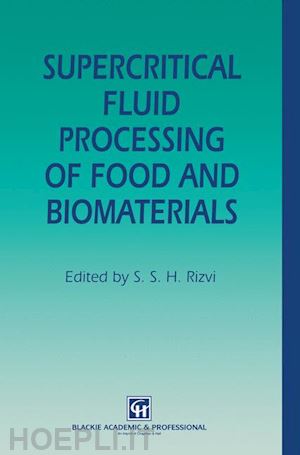1 Fundamentals of processing with supercritical fluids.- Abstract.- 1.1 Introduction.- 1.2 Phase equilibrium and solubility.- 1.2.1 Measurement.- 1.2.2 Theory.- 1.3 Mass transfer operation and economics.- 1.3.1 Theory.- 1.3.2 Scale-up.- 1.3.3 Economics.- 1.4 Biochemical reactions in supercritical fluids.- References.- 2 Carbon dioxide as a supercritical solvent in fatty acid refining: theory and practice.- Abstract.- 2.1 Introduction.- 2.2 Phase equilibria.- 2.3 A case study.- 2.4 Mass transfer.- 2.5 Continuous multistage simulation.- 2.6 Conclusions.- Acknowledgements.- References.- 3 Mass transfer phenomena in supercritical carbon dioxide extraction for production of spice essential oils.- Abstract.- 3.1 Introduction.- 3.2 Theory.- 3.3 Materials and methods.- 3.4 Results and discussion.- References.- 4 Biochemical reactions in supercritical fluids.- Abstract.- 4.1 Introduction.- 4.2 Acidolysis reaction.- 4.3 Materials and methods.- 4.3.1 Reactor.- 4.3.2 Reaction conditions.- 4.3.3 Materials.- 4.3.4 Analysis.- 4.4 Results and discussion.- 4.4.1 Steady state.- 4.4.2 Effect of water.- 4.4.3 Effect of temperature and pressure.- 4.5 Conclusions.- Acknowledgements.- References.- 5 Use of semi-preparative supercritical chromatography for the separation and isolation of flavor and food constituents.- Abstract.- 5.1 Introduction.- 5.2 Materials and methods.- 5.3 Results and discussion.- 5.4 Conclusion.- References.- 6 Separation of oil from fried chips by a supercritical extraction process: an overview of bench-scale test experience and process economics.- Abstract.- 6.1 Introduction.- 6.2 Background.- 6.2.1 High-value, low-volume product.- 6.2.2 Intermediate-value, intermediate-volume product.- 6.2.3 Low-value, high-volume product.- 6.3 Laboratory-scale study of LOWCA process.- 6.3.1 Experimental.- 6.3.2 Apparatus.- 6.3.3 Procedure.- 6.4 Results and discussion.- 6.4.1 Effect of extraction time.- 6.4.2 Effect of pressure.- 6.4.3 Effect of temperature.- 6.4.4 Effect of type of feedstock.- 6.4.5 Effect of CO2 flow rate.- 6.4.6 Physical characteristics of oil-reduced chips and extracted oil.- 6.5 Conceptual design and cost study of LOWCA process.- 6.5.1 LOWCA process flowsheet.- 6.5.2 Cost estimate.- 6.5.3 Estimation of price for LOWCA-processed chips.- 6.5.4 Economic analysis.- 6.6 Technology penetration issues.- 6.7 Conclusions.- Acknowledgements.- References.- 7 Selecting a pump for supercritical fluid service.- Abstract.- 7.1 Introduction.- 7.2 Fluid criteria.- 7.2.1 Lubricity.- 7.2.2 Thermodynamic and thermophysical properties.- 7.2.3 Materials compatibility.- 7.3 Process criteria.- 7.3.1 Flow rate.- 7.3.2 Discharge pressure.- 7.3.3 Differential pressure.- 7.3.4 Net positive suction head.- 7.3.5 Safety and operability.- 7.4 Pump types.- 7.4.1 Positive displacement reciprocating pumps.- 7.4.2 Centrifugal pumps.- 7.5 Applications and selections.- 8 Natural antioxidants produced by supercritical extraction.- Abstract.- 8.1 Introduction.- 8.2 Traditional antioxidants.- 8.2.1 Synthetic antioxidants.- 8.2.2 Natural antioxidants.- 8.3 Spice antioxidant compounds.- 8.4 Extraction of spice antioxidants.- 8.5 Supercritical extraction.- 8.6 Labex™ spice oleoresin SC™.- 8.7 Analytical.- 8.8 Summary.- References.- 9 Separation of ethanol/water solution with supercritical CO2 in the presence of a membrane.- Abstract.- 9.1 Introduction.- 9.2 Materials and methods.- 9.3 Results and discussion.- 9.4 Conclusions.- Nomenclature.- References.- 10 Supercritical fluid fractionation of butter oil.- Abstract.- 10.1 Introduction.- 10.2 Materials and methods.- 10.2.1 Apparatus.- 10.2.2 Analytical methods.- 10.3 Results.- 10.3.1 Influence of process parameters on extraction yield.- 10.3.2 Fractionation of triglycerides.- 10.3.3 Reduction in cholesterol content.- 10.3.4 Melting properties of extraction products.- 10.4 Conclusion.- References.- 11 Supercritical carbon dioxide processing of orange juice: effects on pectinesterase, microbiology and quality attributes.- Abstract.- 11.1 Introduction.- 11.1.1 Conventional applications of SC-CO2 to citrus processing.- 11.1.2 Unconventional applications of SC-CO2 to citrus processing.- 11.2 Materials and methods.- 11.2.1 Orange juice.- 11.2.2 Experimental design.- 11.2.3 Supercritical equipment.- 11.2.4 Thermal inactivation of PE.- 11.2.5 Combined thermal and supercritical inactivation of PE.- 11.2.6 Pectinesterase activity determination.- 11.2.7 Effect of storage on PE and cloud of SC-CO2 treated orange juice.- 11.2.8 pH and °Brix measurement.- 11.2.9 Cloud measurement.- 11.2.10 Ascorbic acid and total acidity measurement.- 11.2.11 Color measurement.- 11.2.12 Microbiological studies.- 11.2.13 Sensory evaluations.- 11.3 Results and discussion.- 11.3.1 Thermal inactivation of PE.- 11.3.2 Combined thermal and supercritical inactivation of PE.- 11.3.3 Effect of SC-CO2 on PE activity and cloud stability during storage at 4.4°C.- 11.3.4 Effect of SC-CO2 on pH and total soluble solids (°Brix).- 11.3.5 Effect of SC-CO2 on cloud.- 11.3.6 Effect of SC-CO2 on total acidity and ascorbic acid.- 11.3.7 Effect of SC-CO2 on color.- 11.3.8 Effects on total microbial plate count.- 11.3.9 Sensory evaluation tests.- 11.4 Summary and conclusions.- Acknowledgements.- References.- 12 Supercritical fluid carbon dioxide technology for extraction of spices and other high value bio-active compounds.- Abstract.- 12.1 Introduction.- 12.2 Pepper oil.- 12.3 Pepper oleoresin.- 12.4 Ginger oil.- 12.5 Ginger oleoresin.- 12.6 Jasmine absolute.- 12.7 Bio-active compounds.- 12.7.1 Fatty alcohols from saponified rice bran wax.- 12.7.2 Down stream processing in bio-technological applications.- 12.7.3 Vanilla absolute.- 12.8 Summary.- References.- 13 Extraction of oil from evening primrose seed with supercritical carbon dioxide.- Abstract.- 13.1 Introduction.- 13.2 Experiments.- 13.2.1 Materials.- 13.2.2 Apparatus and procedures for measuring solubility.- 13.2.3 Apparatus and procedures for extraction.- 13.3 Results and discussion.- 13.3.1 Solubility of evening primrose oil in compressed carbon dioxide.- 13.3.2 Extraction of oil from evening primrose seed.- 13.3.3 Prediction of extraction rate.- 13.3.4 Comparison with n-hexane extraction.- 13.4 Conclusions.- Nomenclature.- References.- 14 High pressure extraction of organics from water.- Abstract.- 14.1 Introduction.- 14.2 Apparatus and methods.- 14.3 High pressure extraction of water solutions.- 14.4 Results and discussion.- 14.4.1 Supercritical extraction of pesticides from water.- 14.4.2 Ethanol/water/CO2.- 14.4.3 Propanol/water/CO2.- 14.5 Conclusion.- Nomenclature.- References.- 15 Production of low-fat and low-cholesterol foodstuffs or biological products by supercritical CO2 extraction: processes and applications.- Abstract.- 15.1 Introduction.- 15.2 General process.- 15.3 Food products: defatting applications.- 15.4 Food products: defatting and decholesterol applications.- 15.5 Biological products: decholesterol applications.- References.- 16 Fractionation of beef tallow with supercritical CO2.- Abstract.- 16.1 Introduction.- 16.2 Materials and experimental methods.- 16.2.1 Supercritical fluid extraction (SFE).- 16.2.2 Determination of cholesterol content.- 16.2.3 Determination of fatty acid content.- 16.2.4 Differential scanning calorimetry of lipid samples.- 16.3 Results and discussion.- 16.3.1 Single-pass SFE.- 16.3.2 Use of the multiple separators.- 16.4 Conclusions.- Acknowledgements.- References.- 17 Supercritical CO2 extraction of oil from a seaweed, Palmaria palmata.- Abstract.- 17.1 Introduction.- 17.2 Materials and methods.- 17.2.1 Material.- 17.2.2 Extraction system.- 17.2.3 Extraction procedure.- 17.2.4 Analysis of extract.- 17.3 Results and discussion.- 17.4 Conclusion.- Acknowledgements.- References.- 18 Commercial feasibility of supercritical extraction plant for making reduced-calorie peanuts.- Abstract.- 18.1 Introduction.- 18.2 Market potential for reduced-calorie peanuts.- 18.3 Plant and process desig











